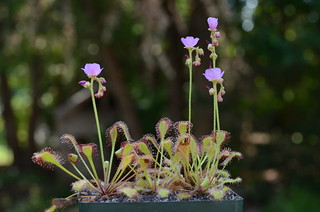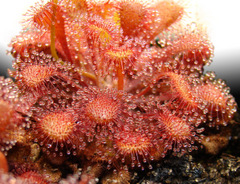Drosera collinsiaeDrosera collinsiae, or Collin's sundew is a lovely subtropical sundew from South Africa. There are two main forms of D. collinsiae in cultivation: the "true" form and the "Faryland" form. The "true" or "typical" form (from various locations) are described by Peter D'Amato as having "upright, spoon-shaped leaves [resembling D. x obovata] on long, thin petioles." Their growth habit resembles that of D. nidiformis. The shape of the leaf lamina can vary depending on the lighting and other conditions they receive. There are a few picture examples in the links to the right.The second form is Drosera collinsiae "Faryland". The "Faryland" form, according to Tamlin Dawnstar (an experienced sundew grower), is possibly a "natural hybrid of Drosera burkeana and Drosera madagascariensis." The leaves of Drosera collinsiae "Faryland" have a fairly unique shape, forming a rosette with leaves somewhat resembling those of D. venusta, but with a much narrower petiole. There are also a few forms floating around, which are mis-labeled D. nidiformis. This includes the D. collinsiae (Magaliesburg) location form. |
|
Young Drosera collinsiae "Faryland", grown from leaf cuttings.
|
Media: Not picky. I use 1:1 peat: sand (silica). Small amounts of perlite can be added as well. I think LFS or live sphagnum could work as well Be sure to rinse your media before you use it Media moisture: try to keep moist. Drosera collinsiae tolerates drier soils farily well. Humidity: not much needed. I'd recommend at least 25%. Try 30+% if you like to be "safer." Pot height: I recommend 4 inches or taller, though it can tolerate small pots. Drosera collinsiae can develop a a long, branching root system. A tall pot will ensure that the plant will never be effected by root rot. The plant in the top 2 pictures plant is growing in a 7-inch pot. Trapping speed: moderate. Leaves will curl noticeably around food within a few hours. Feeding: Feed once every two weeks for rapid, robust growth and flower production. See feeding page. Feeding encourages flowering. If fed while flowering, the plant will start producing large leaves right away. Food size: medium. Plant dimensions: D. collinsiae generally does not form a stem. Leaves can reach approximately 2 inches in length. D. collinsiae "Faryland" normally reaches around 2.25+ inches across at maturity, forming a rosette that slowly forms a skirt of dead growth over time. See middle picture above. Refer to the introductory description for more info on the leaf structure and growth habit of "true" Drosera collinsiae, and the "Faryland" form Temperature: not picky. Has grown well for me in the temp range of 60-85 degrees F. Lighting/Photoperiod: I grow mine under T-8 lights with a 16-hour photoperiod all year-round. Leaves of Drosera collinsiae will turn red or orange-red under bright lighting. Dormancy requirements: None required, but different growth habits may be observed. Can be grown year-round if grown indoors during the cold months. I highly recommend the tray method. However, Drosera collinsiae should come back from the roots if is subjected to mild freezing temperatures. D. collinsiae "Faryland" tends to become more compact habit during the winter months, and may become develop deformed leaves. I kept the photoperiod constant, so this growth is likely controlled solely by temperature. Flowers: D. collinsiae produces beautiful pink flowers. Try assisting self-pollination for better seed-set. Avoid hot temperatures from light fixtures if growing this species indoors. Propagation Techniques(click here to learn more about propagating sundews)Seed: generally easy. no cold stratification required. Can be grown to flowering maturity from seed in about 1-1.5 years if fed approx. every 2 weeks. Leaf-cuttings: easy. water floating method works best. Place directly under lights for the hightest success rate. Root cuttings: Very easy. Roots are thick. Divisions: easy. D. collinsiae tends to form clumps over time. Drosera collinsiae "Faryland also tends to split at the crown, but both sundews have no trouble dealing with repotting and root disturbance, so divisions can be taken easily. |
References: D’Amato, Peter. The Savage Garden. California Ten Speed Press 1998. 133
Additional Questions or Suggestions?
Contact me at: sundewman(at)yahoo.com

